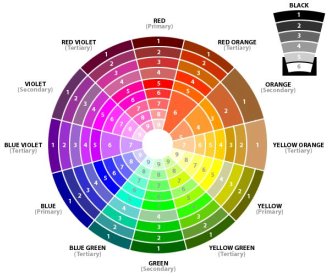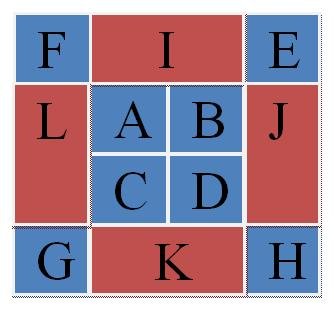|
|
Quilt Blocks
When you are quilting, you break down the quilt into smaller units called quilt blocks. Quilt Blocks are usually made out of patchwork. Patchwork is combining small pieces of material that you bring together to create a repeating pattern, or a random pattern. Most blocks in quilts have similar patterns; however you can create any unique shape, style, or pattern of your block. When deciding how you want your quilt to look think about how your blocks are going to match up.
When creating your quilt you need to think about the color and fabric you want to use in your quilt blocks. These decisions depend on who or where you want to place your quilt. If you are starting your block and you don’t think you are going to like the original colors you picked, go back and ask someone, like the person you are making it for. Sometimes having a second pair of eyes look at it helps.
Tip It’s always worth looking over everything twice before starting, because once you get down the road on your quilt, it is time consuming to change what you have already done. When deciding on the color of your quilt, think about where your quilt is going to be and who will be using it. If it’s for a baby you might want to use a cool color such as blue, purple, green, or a soft pink. Whereas if you want the quilt to liven up a room you might want to consider reds, oranges, or yellows, for they are warm colors and will really brighten up a room. Here are a couple tips when choosing your colors: - Black and white are very good base colors. When using black it will help dim down some of the brighter color, whereas white will help brighten the colors.
- Blues, greens, and purples are considered cooler colors. When you add a lot of white to these colors, the combinations can become sad instead of peaceful.
- When creating a quilt for a bed, and you wish to use reds, orange, or yellow, which can be very intense colors you may want to think about getting fabric that has those colors mixed with a bit of white to help calm down the color.
- If you want the colors on your quilt blocks to really “pop” you may want to take the color you like or have, then look at a color wheel (see below) and choose the color directly across from it. This will make both colors come to life.

- When looking to calm down the colors you have chosen you may want to look at the color wheel and chose a color on the same side. For example to calm down red a little you may want to choose orange.
Also you will want a fabric that fits your specific needs. Here are a couple of tips for choosing a fabric for the beautiful quilt blocks that you are starting to make. - You may want to think of how tight the weave is on the fabric you are choosing. The fabric should last years and years and should be appropriate for the intended use, like washing, sleeping with, and being carried around by children.
When choosing your fabric you probably should stay away from loosely woven fabric for they can cause problems when ripped, torn, or otherwise damaged. Medium woven fabric is a nice mix. It is not too dense and it will last a long time. It can however be a little more difficult to sew. You can never go wrong with 100% cotton. If you are a beginning quilter, start with 100% cotton. - Always buy a little more material then you need. It never hurts to have extra. And you prevent the problem of running out, and finding your favorite quilting store not having the inventory to get the extra you need.
- And if you are not sure if the color will run, wash the fabric beforehand. It is always a good idea in any case, for no one really knows where the fabric was before you had it.
When cutting out the material for your quilt blocks, remember to always measure your material twice. You don’t want to finish your quilt and realize that one of your quilt blocks is smaller. Also be sure to provide a 1/4" seam allowance around each piece of your block that will go into your quilt block.
A popular method used to create quilt blocks is Foundation or Paper Piecing. Originally (1700's) it was called Foundation Piecing. Pieces of scrap fabric were used as a foundation to piece together quilting blocks. Today, Paper Piecing uses tracing paper or other heavy weight papers for quilting block patterns. Often the exact measurements including seam allowance, and fabric colors are written right on the Paper Pieces.
In Paper Piecing, a shorter stitch length (12 stitches per inch) is used when sewing together the block pieces over the paper pieces. This shorter stitch length allows for the easier tearing away of the foundation paper after the block sewing is completed. A good needle size to use is 14 (American) or 90 (European).
Also if your fabric has a pattern you want to make sure you cut all your blocks in the same direction. You don’t want to get stuck with no material left and one block with the pattern on its side. It is a good idea to lay out your pieces for your block in the order you are putting them together, making sure everything is facing up and that everything is turned the right way. This way when you start sewing you know that everything is right. After you have added your appliqué to the pieces of your block, you are ready to assemble you blocks. When assembling you blocks you should start in the middle. So if yours pattern for you quilt looks like this:

You are going to want to: - Start out by sewing A and B together first. Overlap the 1/4" seam allowance for these two pieces as well as all the remaining pieces of your block.
- Then you are going to want to sew C and D together.
- After you have A and B, and C and D you now want to sew A and B to C and D. Make sure all the blocks are going the right way before you start to sew.
- Now you want to sew J to your block of A, B, C, and D.
- Once that is done sew the L block to your A, B, C, D, J, block. After you have finished that set it aside.
- Now you will need to sew blocks, F, I, E together, so that they are in a line. Making sure that once again they are all facing the right way.
- Do the same thing with blocks G, K, and H.
- Once you have both all 3 of your blocks you are ready to finish sewing them together. Sew your middle block (A, B, C, D, J, L) to your upper (F, I, E) and your lower (G, K, H). You have now sown all your blocks together and have your top to your beautiful quilt now.
Here are some final tips when sewing your blocks together: - Always make your fabric is going the right way. It is very easy to accidentally sew a block the wrong way. Always check how you’re sewing it.
- When pinning your blocks together, keep your pins close together. This will help to make sure that the fabric is not lose in some areas.
- It is a good idea to press your fabric before and after you have sewed in your seams. And just like making sure your fabric is going the right way, it is a good idea to press the sewn seams in the same direction.
You have now finished assembling the pieces of your block.
Return from Quilt Blocks to Quilting Home
|
|
|





